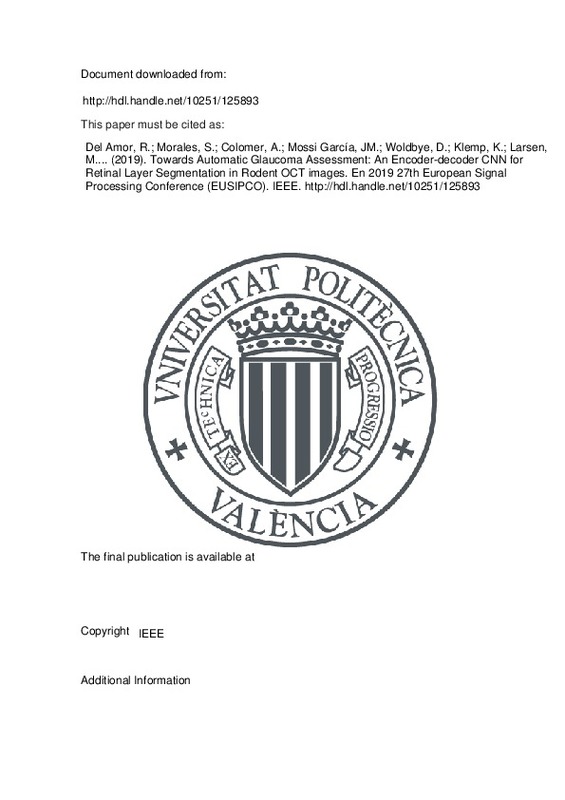JavaScript is disabled for your browser. Some features of this site may not work without it.
Buscar en RiuNet
Listar
Mi cuenta
Estadísticas
Ayuda RiuNet
Admin. UPV
Towards Automatic Glaucoma Assessment: An Encoder-decoder CNN for Retinal Layer Segmentation in Rodent OCT images
Mostrar el registro sencillo del ítem
Ficheros en el ítem
| dc.contributor.author | del Amor, Rocío
|
es_ES |
| dc.contributor.author | Morales, Sandra
|
es_ES |
| dc.contributor.author | Colomer, Adrián
|
es_ES |
| dc.contributor.author | Mossi García, José Manuel
|
es_ES |
| dc.contributor.author | Woldbye, David
|
es_ES |
| dc.contributor.author | Klemp, Kristian
|
es_ES |
| dc.contributor.author | Larsen, Michael
|
es_ES |
| dc.contributor.author | Naranjo Ornedo, Valeriana
|
es_ES |
| dc.date.accessioned | 2019-09-17T12:32:43Z | |
| dc.date.available | 2019-09-17T12:32:43Z | |
| dc.date.issued | 2019 | |
| dc.identifier.isbn | 978-9-0827-9702-2 | |
| dc.identifier.issn | 2076-1465 | |
| dc.identifier.uri | http://hdl.handle.net/10251/125893 | |
| dc.description.abstract | [EN] Optical coherence tomography (OCT) is an important imaging modality that is used frequently to monitor the state of retinal layers both in humans and animals. Automated OCT analysis in rodents is an important method to study the possible toxic effect of treatments before the test in humans. In this paper, an automatic method to detect the most significant retinal layers in rat OCT images is presented. This algorithm is based on an encoder-decoder fully convolutional network (FCN) architecture combined with a robust method of post-processing. After the validation, it was demonstrated that the proposed method outperforms the commercial Insight image segmentation software. We obtained results (averaged absolute distance error) in the test set for the training database of 2.52±0.80 µm. In the predictions done by the method, in a different database (only used for testing), we also achieve the promising results of 4.45 ± 3.02 µm. | es_ES |
| dc.description.sponsorship | This work was supported by the Project GALAHAD [H2020-ICT-2016-2017, 732613]. | es_ES |
| dc.format.extent | 5 | es_ES |
| dc.language | Inglés | es_ES |
| dc.publisher | IEEE | es_ES |
| dc.relation.ispartof | 2019 27th European Signal Processing Conference (EUSIPCO) | es_ES |
| dc.rights | Reserva de todos los derechos | es_ES |
| dc.subject | Optical coherence tomography | es_ES |
| dc.subject | Rodent OCT | es_ES |
| dc.subject | Layer segmentation | es_ES |
| dc.subject | Convolutional neural networks | es_ES |
| dc.subject | Glaucoma assessment | es_ES |
| dc.subject.classification | TEORIA DE LA SEÑAL Y COMUNICACIONES | es_ES |
| dc.title | Towards Automatic Glaucoma Assessment: An Encoder-decoder CNN for Retinal Layer Segmentation in Rodent OCT images | es_ES |
| dc.type | Capítulo de libro | es_ES |
| dc.type | Comunicación en congreso | es_ES |
| dc.relation.projectID | info:eu-repo/grantAgreement/EC/H2020/732613/EU/Glaucoma – Advanced, LAbel-free High resolution Automated OCT Diagnostics/ | es_ES |
| dc.rights.accessRights | Abierto | es_ES |
| dc.contributor.affiliation | Universitat Politècnica de València. Instituto Universitario de Telecomunicación y Aplicaciones Multimedia - Institut Universitari de Telecomunicacions i Aplicacions Multimèdia | es_ES |
| dc.description.bibliographicCitation | Del Amor, R.; Morales, S.; Colomer, A.; Mossi García, JM.; Woldbye, D.; Klemp, K.; Larsen, M.... (2019). Towards Automatic Glaucoma Assessment: An Encoder-decoder CNN for Retinal Layer Segmentation in Rodent OCT images. En 2019 27th European Signal Processing Conference (EUSIPCO). IEEE. http://hdl.handle.net/10251/125893 | es_ES |
| dc.description.accrualMethod | S | es_ES |
| dc.relation.conferencename | European Signal Processing Conference (EUSIPCO) (formerly European Signal and Image Processing Conference) | es_ES |
| dc.relation.conferencedate | Septiembre 02-07,2019 | es_ES |
| dc.relation.conferenceplace | A Coruña, España | es_ES |
| dc.type.version | info:eu-repo/semantics/publishedVersion | es_ES |
| dc.relation.pasarela | S\393233 | es_ES |
| dc.contributor.funder | European Commission | es_ES |





![[Cerrado]](/themes/UPV/images/candado.png)

